Part 4: Bonn
Maarinke's aunt & uncle met us at Bonn/Cologne (French for good smell? - thanks for the gag, Dad) airport and the final leg of our tour commenced. Through a most fortuitous set of circumstances, our accomodation was slightly more upmarket than the backpackers hostels to which we had become accustomed, starting with the view from the window over the Rhine.
We strolled from Lis and Joachim's house around the centre of Bonn. It was the capital of West Germany until reunification. While the parliament moved to Berlin almost straight away, many of the ministry offices have remained in Bonn and there has been significant private sector investment so that, rather than decline into something of a ghost town as could have occured, it has remained a bustling city. Before becoming the West German capital, it was a relatively prosperous town that at one stage was the capital of the principality of Cologne. It has a big, prestigious university and was, amongst other things, the birthplace of Beethoven.
He is celebrated with a statue in the town square,

 and his house is now a museum,
and his house is now a museum, 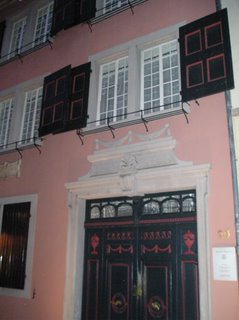
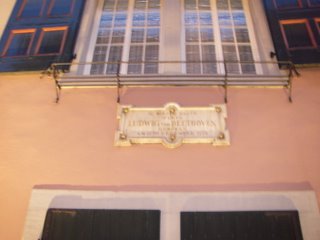 Preparations were already afoot for the annual Carnival, a traditional celebration over the lent period, which apparently involves liberal use of amusing costumes.
Preparations were already afoot for the annual Carnival, a traditional celebration over the lent period, which apparently involves liberal use of amusing costumes.
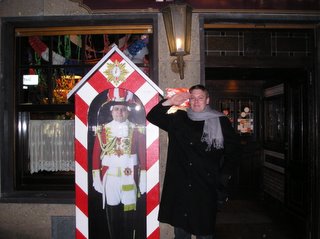
We were introduced to Bonnsch beer, consumed in much smaller glasses than in Bavaria - so that the beer doesn't warm up before one finishes drinking it, and cuisine - hearty, meat-dominated, best appreciated after at least 8 of the aforementioned Bonnsch beer.
________________________________________________________________
The next day, we travelled south along the Rhine, to see castles and vineyards and cliffs.
My previous experience of the Rhineland, a train ride from Cologne to Frankfurt in 2004, had been severely hampered by the aftereffects of an over-ambitious beer tasting session (52 beers tasted) on the last night of a conference in Leuven, Belgium, so i was looking forward to the twin benefits of a functioning brain and expert local guides. We drove south from North Rhine-Westphalia to Rhineland-Palatinate, crossed the Moselle at Koblenz, then stopped off in Bacharach to have a look at the coolest youth hostel I've ever seen, the Jugendherberge Stahleck, which is a castle on the edge of the cliff.
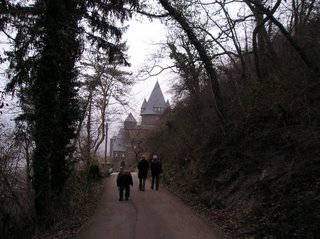
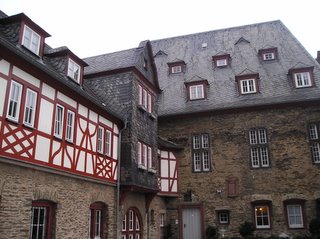

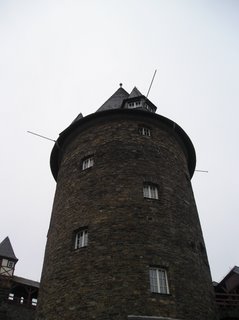
The view was amazing, though with windchill factor it was probably about 10 below, well outside my comfort zone.
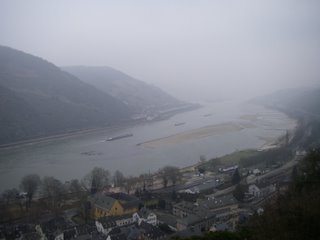
Reaching Bingen, we crossed the river on a ferry on our way to see the Germania monument.
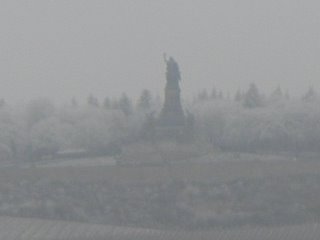 Heeding the warnings, the car was returned safely to terra firma.
Heeding the warnings, the car was returned safely to terra firma.
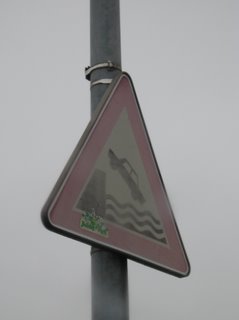 Having fortified ourselves with hot chocolates and hefty servings of torte in Rudesheim, we headed up the hill, above the snowline,
Having fortified ourselves with hot chocolates and hefty servings of torte in Rudesheim, we headed up the hill, above the snowline,
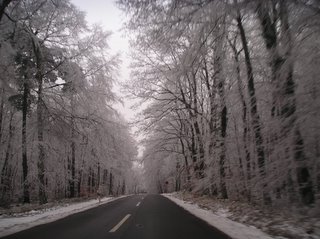
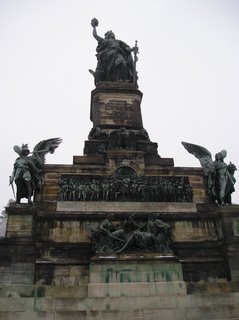
Whilst the monument is regarded as being a bit anachronistic in a symbolic sense, it looks cool and the view is good.
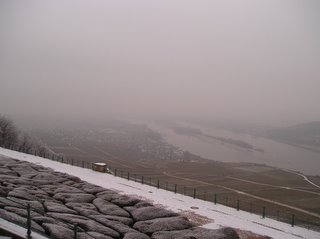
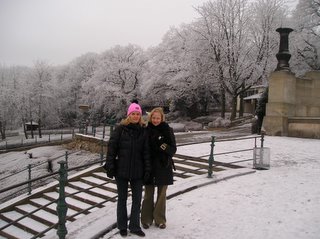
Back down the hill,
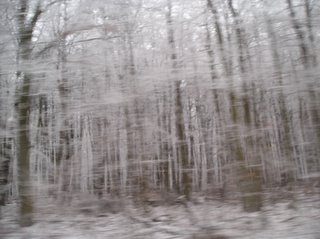 we continued along the Rhine past the Lorelei, the treacherous rocks onto which sailors have been tempted for centuries by sirens, and made famous by Heine's poem.
we continued along the Rhine past the Lorelei, the treacherous rocks onto which sailors have been tempted for centuries by sirens, and made famous by Heine's poem.
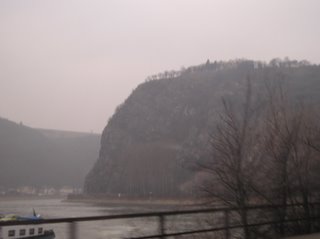
...She combs with a comb that is golden, And sings a weird refrain; That steeps in a deadly enchantment The listener's ravished brain...
The Nibelung hoard (of Wagner's Ring Cycle fame) is also, according to legend, buried under there. On the topic of Nibelungs, Siegfried a hero of the Nibelungenlied, the 'German Iliad', was supposed to have slayed a dragon living in a mountain near Bonn, called Drachenfels, that we had driven past that morning.
Returning to Bonn, we exchanged castles, romantic monuments and historical tales for the trappings of a modern capital,
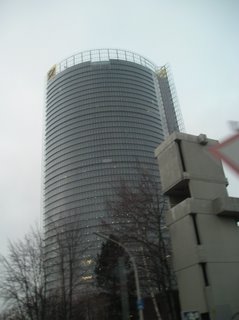 and a tasty dinner at Lis and Joachim's house
and a tasty dinner at Lis and Joachim's house
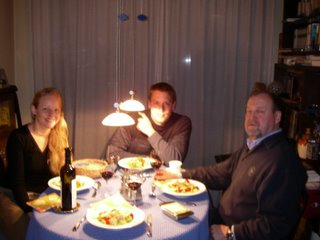
__________________________________________________________
A marked improvement in the weather the following morning enabled the view from the hotel room to be appreciated properly:
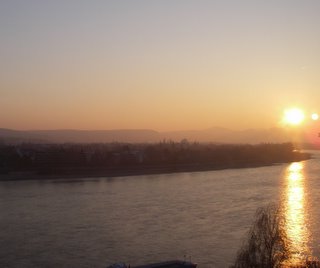 The aim for the day was for Maarinke to become acquainted with her Dutch roots with a quick trip to Holland. Driving west, a discernible flattening of the landscape was noted, in sharp contrast to the craggy cliffs of the previous day. The presence of windmills, albeit not so traditional, indicated that we were getting close.
The aim for the day was for Maarinke to become acquainted with her Dutch roots with a quick trip to Holland. Driving west, a discernible flattening of the landscape was noted, in sharp contrast to the craggy cliffs of the previous day. The presence of windmills, albeit not so traditional, indicated that we were getting close.
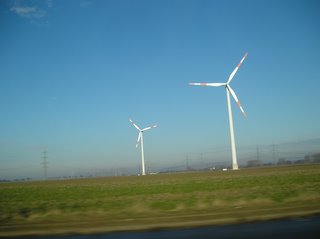
Maarinke was pretty excited as we crossed the border into Holland,
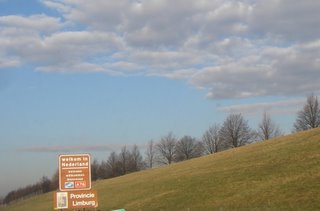
entering the province of Limburg. Situated in the far south-east of the Netherlands, tucked between Belgium and Germany, it comprises about half of the original Duchy of Limbourg, which was split when Belgium seceded from the Kingdom of the Netherlands in 1830. Maastricht and surrounds chose to stay with the Dutch whereas the towns of Limbourg and Liege joined the Wallonian region of Belgium.
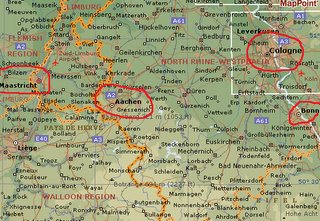
Maastricht, situated on the Meuse (Maas) River, is one of the oldest cities in the Netherlands, having been originally settled by the Romans, though it is more recently famous for the Maastricht treaty. Signed there in 1992, this led to the formation of the European Community and subsequently the European Union, and the introduction of the Euro and associated monetary policy.
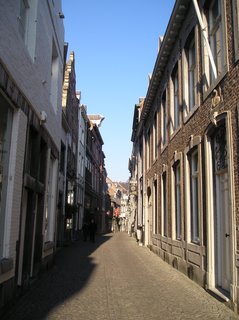
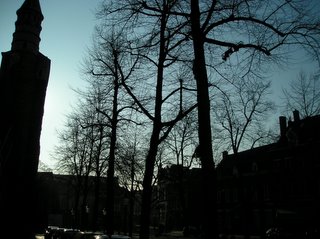
We had a stroll around the streets and squares,
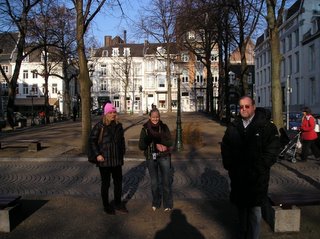
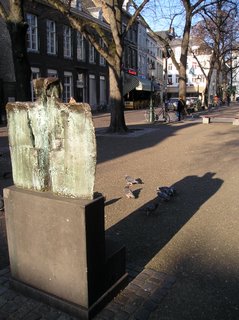 stopped off for some Dutch staples: coffee, white beer, cake (Limburgse vlaai, I think...) and krokets. Mmm, unidentified & fried.
stopped off for some Dutch staples: coffee, white beer, cake (Limburgse vlaai, I think...) and krokets. Mmm, unidentified & fried.
The Van der Meulens were able to live up to their name (From the Mill):
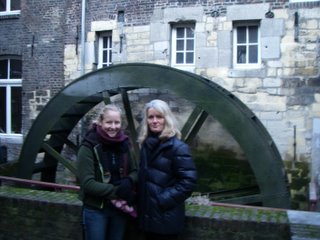
We wandered a bit more around the town, having a look at the Vrijthof,
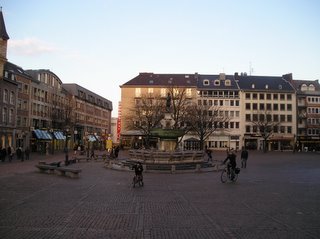
and the Basilica of St Servatius,
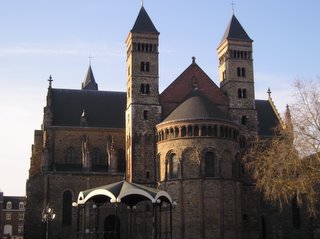
Crossed the Maas,
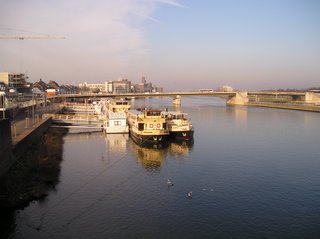
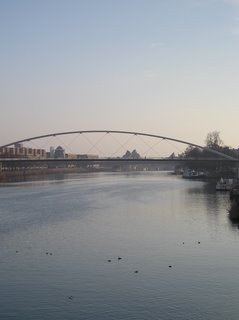
and had a look down towards the buildings where the treaty was signed:
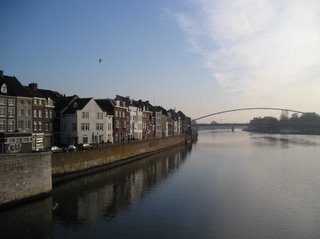 Downed a couple of authentic Dutch beers in De Bobbel,
Downed a couple of authentic Dutch beers in De Bobbel,
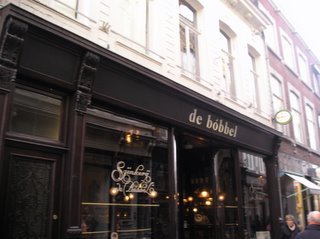
and bade Holland farewell.
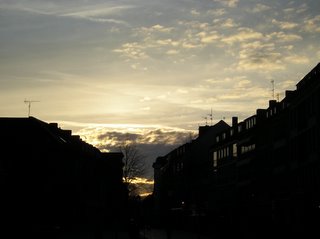 Back in Germany, we stopped off in Aachen (see map above) which was the seat of the Holy Roman Empire under Charlemagne aka Carolus Magnus, the founding father of both France and Germany and ancestor of all the royal families in Europe.
Back in Germany, we stopped off in Aachen (see map above) which was the seat of the Holy Roman Empire under Charlemagne aka Carolus Magnus, the founding father of both France and Germany and ancestor of all the royal families in Europe.
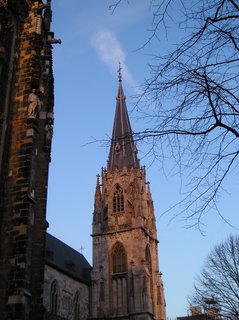 The cathedral was initially built by him (this octagonal section),
The cathedral was initially built by him (this octagonal section),
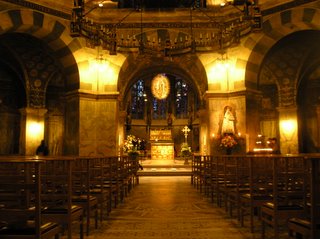
and in fact contains his remains.
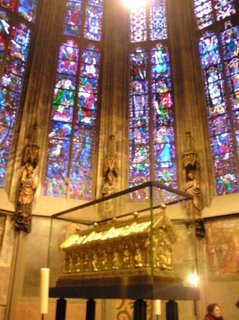
How appropriate that, after visiting the site of the treaty which led to the creation of the Euro and the European Union, we should be paying tribute to Charlemagne, the head of the first united European empire since the Romans, and arguably the Father of Europe. A big day for pan-Europeanism!
And a big day for cool gargoyles too.
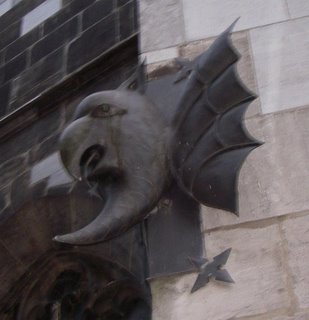
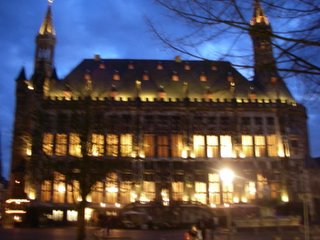
What a fascinating and important corner of Europe. Within a few hundred kilometres radius, there are five countries, territory that has been variously ruled or occupied by the Romans, Celts, Carolingians, Burgundians, Habsburgs, both Spanish and Austrian, the French, Prussians, Germans and now, some might say, the Eurocrats in Brussels. The original seat of the Holy Roman Empire in Aachen, the European Parliament in Strasbourg, the European Commision in Brussels, the treaty of Maastricht, Luxembourg, the original capital of the European Coal and Steel Community and now location of the European Court of Justice and European Investment Bank, the European Central Bank in Frankfurt are all within an hour or two's drive. While the EU has expanded eastward (as well as other directions...) from it's original base, and forseeably will continue to do so, much of the administration and consequently power remains concentrated in this relatively small, traditionally prosperous region.
Heading back to Bonn, we gave the European food and culture a rest with dinner at a Mexican restaurant and called it a night, satisfied after having achieved my second quickest trip to a country, almost eclipsing my memorable 3.5 hour jog around Luxembourg in 04.
__________________________________________________________
The weather had regressed again but, undaunted, we set out to Cologne, just north of Bonn on the Rhine (see above map again). It was raining there also, a phenomenon that might presumably be termed Colognic irrigation. Boom boom.
First stop, the Museum Ludwig,
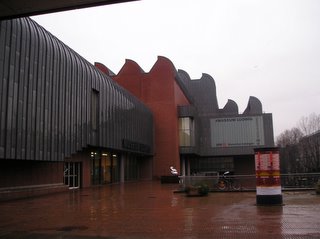
which contains an amazing collection of modern art, both German and international. In particular, the biggest private collection of Picasso paintings in the world was endowed to the museum.
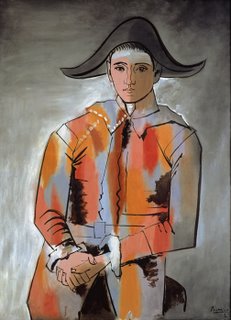
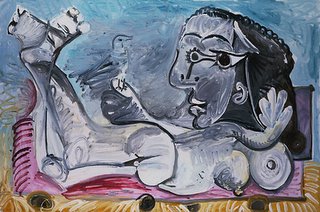 In addition, there were large offerings of Russian modernists,
In addition, there were large offerings of Russian modernists,
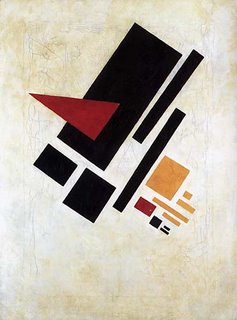
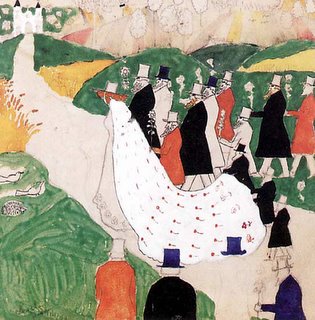 German expressionists,
German expressionists,
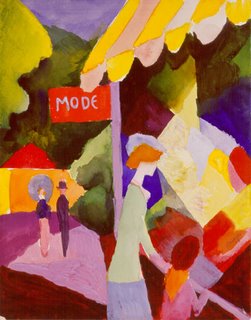
and American pop-art.
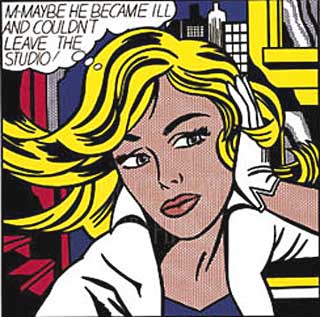
Here we are outside the Romisch-Germanisches Museum - the Roman's were apparently kind enough to leave enough ruins and artifacts in and around Colonia Agrippinensis, a colony in Germania Inferior settled under "agreement" with the resident barbarians, the Ubii, and in fact the northernmost Roman settlement, that an entire museum can be devoted to this today.
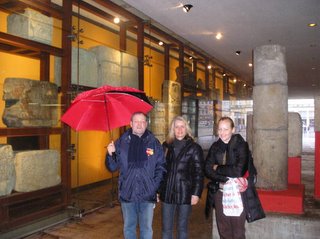
It must be admitted that Roman history was passed up in favour of Phase II of Lunch. It was deemed that baguettes and lattes at the Ludwig museum were not enough for us to grow up into big men, so we needed some further sustenance, in the form of Kolsch beer and meat, hearty quantities of both.
This is the guy in charge of filling up the beer glasses, a noble calling in deed.
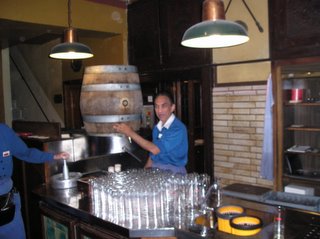
Here is the meat. A local delicacy we were assured.
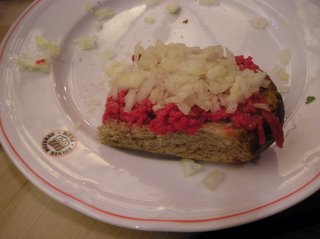
Maarinke could not be persuaded to compromise her vegetarianism (again), even in the name of authentic experience, so i had no choice but to give it a go.
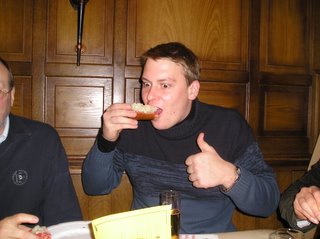
Not bad, though i don't think i'll be trying to make it for myself at home. Especially given that home is in the land of mad cow disease. Subsequent meat was somewhat more cooked, and just as good:
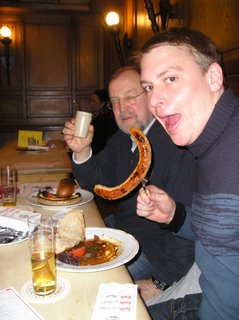
Properly fed now, we were prepared to visit Cologne Cathedral, the largest (and on that day, one of the coldest) Gothic church in northern Europe and, in the 1880s, the world's tallest structure.
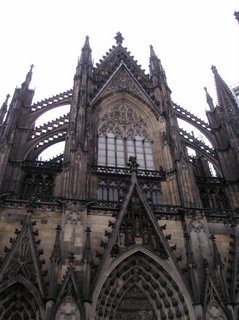
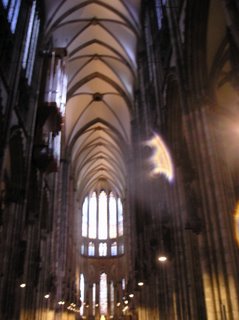
These boxes, the Sarcophagi of the Magi, allegedly contain the remains of the three wise men.
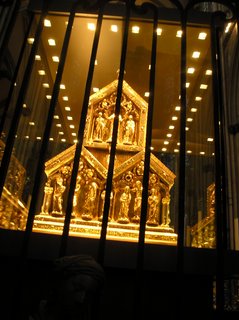
Frederick Barbarossa, a descendant of Charlemagne, flogged them, in the grand northern tradition of looting the cultural treasures of southern Europe (Elgin marbles, Pergamon, etc), from Milan. Presumably he was allowed by the Archbishop of Cologne to feel absolved of his transgression, having donated them to the cathedral.
Returning to Bonn, we headed along to Kunst Museum Bonn. Having been the capital, Bonn is notably endowed with museums. The collections in the Kunstmuseum originated earlier than that and are very strong in local works, those of Macke, a Bonn resident, and the other Rhenish Expressionists,
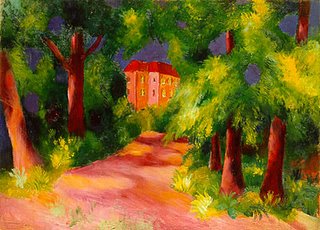
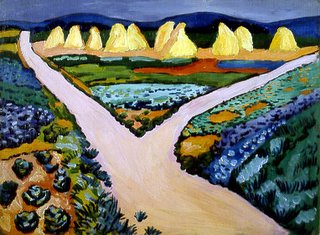
and Joseph Beuys, who hailed from Dusseldorf.
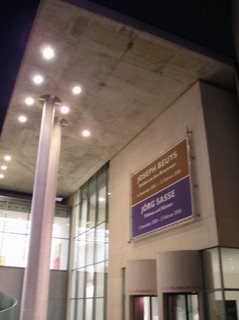
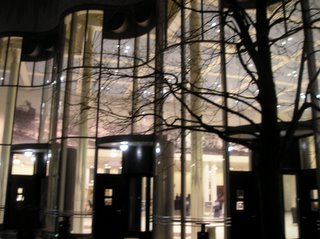
Lis and Joe were kind enough to take us out for an excellent final night dinner at their favourite Italian restaurant:
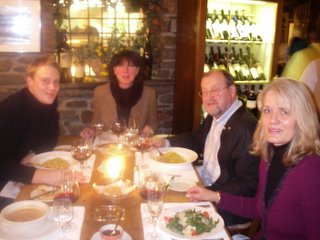
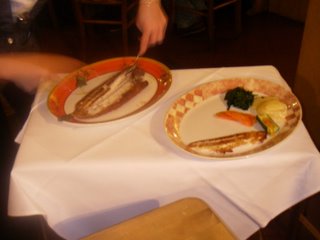
A fabulous meal, endowed in both quality and quantity, of which a notable highlight was the grappa dessert, berry sorbet with about half a litre of grappa poured over the top. Jollity ensued from all quarters.
_______________________________________________________________
Our final morning, and time for little else than farewells in Cologne (note grand and iconic cathedral in background),
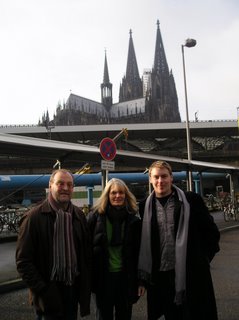
Off, through snowy forests and fields,
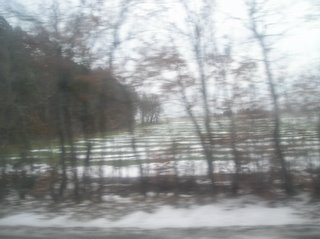
to Hahn airport
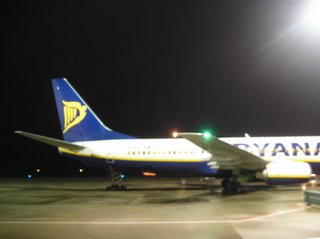 and back to Old Blighty.
and back to Old Blighty.
What a fantastic conclusion to our Eurotour! Four days in and around the Rhineland, four cities in two countries, too much food over at least five culinary traditions, innumerable museums, churches, monuments, sights and delights. Lis and Joachim were wonderful & generous hosts, showing us an excellent time, for which we were most grateful.
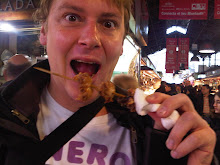

0 Comments:
Post a Comment
<< Home